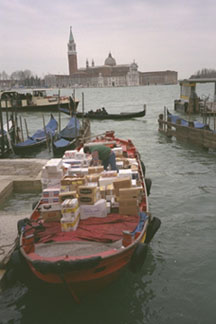If the rate of ground subsidence follows the current quickening trend, Venetians may find themselves standing knee-deep in some pretty foul water before the century is over. The proposed flood control project will install gates that will automatically rise and stop the flow of water between the Venetian Lagoon and Adriatic Sea whenever the tide rises 100 centimeters above the 1897 average. Ammerman and McClennen calculate a potential rise in relative sea level of 30 centimeters over the next 100 years that takes into account a small safety margin (4 centimeters) and any potential rise in sea level due to global warming, in addition to the historical average.

Proposed floodgates that will cut off the lagoon
from the Adriatic Sea during especially high tides
may excacerbate pollution in the Venetian Lagoon.
Philip Greenspun.

